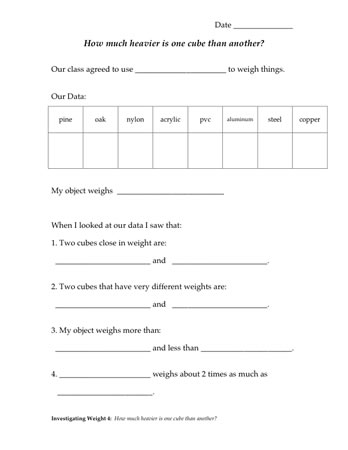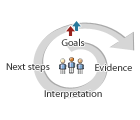How much heavier is one cube than another?
Plan Investigating Weight 4
Paper clips … washers … counting bears … choose one!
Formative Assessment
Available online at inquiryproject.terc.edu
Students weigh the cubes as well as their personal objects with everyone using the same standard unit of measurement. They record the weights (in number of paper clips, washers, or plastic bears) in a class table and place the cubes on a weight line. Students now have the data they need to address the investigation question: How much heavier is one cube than another? They also have an opportunity to compare two representations of the data—the table and the weight line—and to reflect on what each representation has to offer.
By the end of the investigation, students will start to quantify the difference in the weights of the cubes. They will also begin to appreciate the continuous nature of the weight line.
Learning Goals
- to measure and compare weights using a single measure
- to understand that there can be many different weights between any two weights
| Sequence of experiences | ||
|---|---|---|
| 1. Ask the question | All Class | 5 Mins |
| 2. Weigh the cubes | Small Groups | 15 Mins |
| 3. Make meaning | All Class | 15 Mins |
| 4. Make everyday connections | Small Groups | 10 Mins |
Materials and Preparation
For the class:- Post the investigation question in a place where all students can see it.
- Post the class data table for recording the weights of the cubes; an example is shown in Step 2.
- Place the class weight line with its index card label in an easily accessible place, preferably where it can remain for a while for reference.
- 180 bears or 250 metal washers or 600 jumbo paper clips
- 2 sets of cubes
- 1 index card labeled with the chosen unit of measure
- 2 pan balances
- 4 personal objects
Concept Cartoon

The Weight Concept Cartoon is typically used as a formative assessment at the end of this investigation.
Notebook Pages
Do students understand that there are many weight values (possible weights) between any two numbers, for example, between 3 and 4?
By listening to their discussion, you can find evidence of students' understanding of what their measurement readings do and don't tell them. In the following classroom, students have found that one cube was heavier than another but measured in bears, their weights are the same (2 bears).
As she interprets students' ideas, Jen listens for the idea that a cube is unlikely to weigh exactly a whole number of bears. One cube may weigh between 2 and 3 bears but closer to 2, and another cube between 1 and 2 bears but closer to 2. Thus the two cubes weigh the same number of whole bears and yet one cube actually weighs a little more than the other.
As a next step, the teacher in this class encouraged students to suggest other explanations.






